UPDATED: January 22, 2023
Your Kinetico reverse osmosis drinking water system has been working just fine, but all of a sudden you notice that the water flow is not what it used to be.
The water flow has slowed down dramatically compared to what it was just a short time ago or maybe the flow has stopped altogether. Why did my Kinetico reverse osmosis drinking water system stop working?
A Kinetico reverse osmosis drinking water system’s water flow may slow down because the filters need to be changed, the filters are installed incorrectly, poor incoming water pressure, or an improper functioning storage tank.
If you are a Do-It-Yourselfer, you will likely be able to fix your water flow problem yourself. Read on and find out what you may be able to do to get your Kinetico reverse osmosis working properly again.
Which Type Of Kinetico Reverse Osmosis System Do You Have?
Aquakinetic/A200/K2 (No Blue Indicator) or a model GX, K5 (With Blue Indicator)
There have been several different models of Kinetico reverse osmosis systems over the years.
But to find out why your Kinetico reverse osmosis system has slowed down or stopped working altogether, we need to check if your system has a blue filter indicator or not.
- If your Kinetico reverse osmosis system has a flat top, it does NOT have a blue filter indicator.
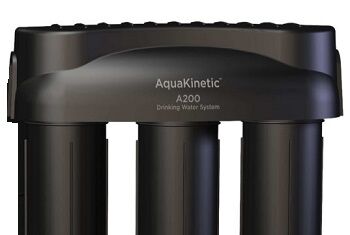
- If your Kinetico reverse osmosis system has a clear window on one end of the top of your system that looks like the image below, then your Kinetico reverse osmosis system does have a blue filter indicator.
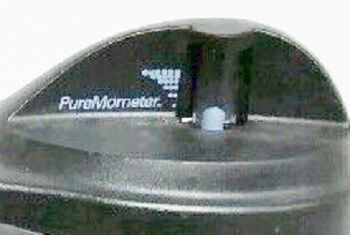
Take a look at the top of your reverse osmosis system to see if your system has a blue filter indicator and then follow the instructions below for your type of Kinetico, reverse osmosis system.
Why Did My Kinetico Reverse Osmosis Slow Down?
– Kinetico Reverse Osmosis Systems (Without) A Blue Indicator
- Poor Air Pressure In Your Kinetico RO Storage Tank:
A Kinetico reverse osmosis system that does NOT have a blue indicator is very much like any popular reverse osmosis drinking water system as it uses an “AIR” charged water storage tank.
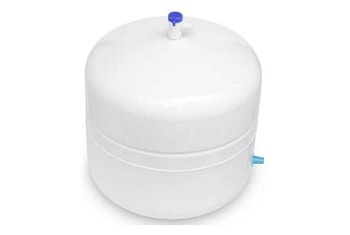
A slow flow of water from your reverse osmosis faucet is most likely due to poor pressure in your reverse osmosis storage tank.
If your Kinetico reverse osmosis drinking water system does NOT have a Kinetico “Quick-Flo” storage tank, it uses a standard “AIR” pressurized water storage tank just like most popular reverse osmosis systems.
It may be colored black to make it match the Kinetico reverse osmosis system but it is just a standard reverse osmosis storage tank that can lose air pressure over time which will result in slower water flow from the system.
To check how well your Kinetico “AIR” pressure storage tank is working and instructions on how to get it working properly again, check out my article on how to repressurize your reverse osmosis storage tank.
If you would like to get more water from your Kinetico reverse osmosis system (with a standard “AIR” charge storage tank) check out my recommended RO Storage tanks for a larger tank to store more water.
– Kinetico Reverse Osmosis Systems (With) A Blue Indicator
Kinetico uses a blue filter indicator on their GX and K5 reverse osmosis systems to allow you to check the “Approximate” life that is left in the filters of your system.
This blue indicator starts out going nearly to the top of the indicator window and then gradually works its way down as water goes through the system’s “Post” filter.
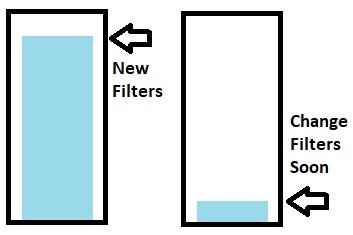
The “Post” filter is usually Blue for the older GX reverse osmosis system or Orange for the K5 reverse osmosis system.
Both the “Blue” and the “Orange” Kinetico reverse osmosis filters have a small black screw in the center of their opening that is slowly turned down by the blue indicator as water flows through the system.

After 500 gallons of water have been filtered by the system, the small black screw drops out into the post filter and allows the blue indicator to drop and “Shut Down” the water from flowing through the post filter.
Once your Kinetico reverse osmosis system with a blue indicator has filtered 500 gallons of water, the flow of water coming out of your Kinetico reverse osmosis faucet will drop considerably and immediately.
Kinetico says that this is done so that you can’t use the filters for more than the 500 gallons of water that they are designed to filter which helps to protect the system.
If you notice that the flow of water from your Kinetico reverse osmosis system has a “Blue” indicator on it, check for the blue indicator in the clear window.
If you can no longer see the blue indicator, you have used the 500 gallons of water that the filters are designed to filter and it is time to change the filters.
Once you have changed your Kinetico reverse osmosis filters, the recovery of strong water flow should be immediate.
Why Did My Kinetico Reverse Osmosis Stop Completely?
– Kinetico Reverse Osmosis Systems (With Or Without) A Blue Indicator
In most cases, the water flow from your Kinetico reverse osmosis system should not stop completely.
But if you find that the water has completely stopped coming out of your reverse osmosis faucet, there are a few things that you can check before you call your Kinetico dealer.
There are normally 2 shut-off valves to a Kinetico or other popular reverse osmosis systems. If either one of these valves is shut off, you will not have water coming out of your reverse osmosis system.
Is The Water Supply To Your Reverse Osmosis System Turned On?
You may not have had any reason to shut off the water supply to your Kinetico reverse osmosis system recently, but sometimes a lever can get turned accidentally or someone may have turned the wrong lever, shutting off the water supply to your system.
All reverse osmosis systems need a supply of unfiltered water in order to produce filtered reverse osmosis water.
Most reverse osmosis systems are installed with a simple shut-off valve which is a small lever that can easily be accidentally turned simply by moving around items next to your reverse osmosis system.
I have always installed Kinetico and other popular reverse osmosis drinking water systems with 2 standard 90-degree shut-off valves. One shut-off valve for the reverse osmosis storage tank and a second valve connected to the cold water supply.
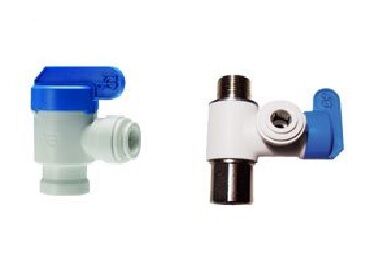
This valve is usually installed directly to the top of the water shut-off valve that connects to the cold water supply to your sink.
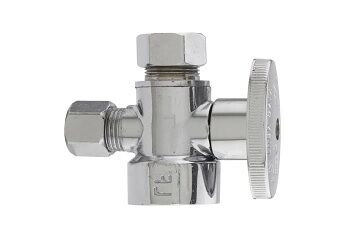
If this valve gets tapped or hit by an object (like cleaning products) being moved underneath your sink, it may shut off the supply of water for your reverse osmosis system.
No water going to your Kinetico or other popular reverse osmosis systems means no water coming out of your reverse osmosis system!
Is Your Reverse Osmosis Water Storage Tank Turned On?
Just like not having water supplied to a reverse osmosis system means that it will not be able to create filtered reverse osmosis water, if the supply of water from your storage tank is shut off, no water will come out of your faucet.
Some reverse osmosis storage tanks have a shut-off valve directly connected to the tank and some may have the valve connected to the tubing that is going from the tank to the faucet, but either way, they pretty much look the same.
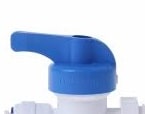
Just like a reverse osmosis water supply valve, the shut-off valve going from a reverse osmosis storage tank can get accidentally shut off or you simply may have not remembered to turn it back on.
Make sure that the lever is pointing in the same direction as the water tubing or pipe. This is the “ON” position that will allow water to flow through the valve.
Is There A “LEAK DETECTOR” Shut-Off Valve On Your System?
Most Kinetico reverse osmosis systems are NOT installed with a LEAK DETECTOR Shut-Off, but I think that all reverse osmosis systems should be.
A leak detector shut-off is just what it sounds like!
If water leaks onto the surface where the valve is installed, the valve closes and stops water flowing to the reverse osmosis system to stop the leak from continuing.
There is a small disc in the leak detector that expands when it comes into contact with water which seals the valve and shuts off the water supply.
Leak detectors are very inexpensive, easy to install, and can save you lots of money in costly repairs that can be caused by a leak that goes undetected.
Is There Any “Kinked” Tubing On Your RO System?
A Kinetico reverse osmosis system is normally installed with plastic tubing that can become “Kinked” when bent at a sharp angle just like when you bend a garden hose to stop the water flow.

Simply turning a reverse osmosis storage tank or moving around household products that you may store by your reverse osmosis system may cause a section of tubing to kink and stop the flow of water through your system.
Check all of the tubes connected to your reverse osmosis system to ensure that the tubing has no sharp turns (Kinks) that may be causing restrictions in water flow.
The tubing does not have to be perfectly straight, just make sure that it is not sharply bent.
You May Have A Clogged Filter Or Membrane!
Having a clogged membrane is NOT the most common cause of no water from a Kinetico or other popular reverse osmosis systems but hard minerals, iron, and debris can clog a reverse osmosis membrane.
If you have changed your reverse osmosis filters and have checked all of the other possibilities in this article, you may need to change the membrane of your reverse osmosis system.
Kinetico has a limited 10-year warranty on their reverse osmosis membranes, so check with your Kinetico dealer before changing your Kinetico reverse osmosis membrane.
How Do I Know If I Need To Change My Kinetico RO Filters?
– Kinetico Reverse Osmosis Systems (With) A Blue Indicator
If you can still see the blue indicator in your Kinetico reverse osmosis system, your filters should still be OK and not need to be changed.

If you look into your viewing window and do NOT see the blue indicator at all, your Kinetico post-filter has tripped and the filters will need to be changed.
– Kinetico Reverse Osmosis Systems (Without) A Blue Indicator
It is commonly recommended to change your Kinetico reverse osmosis filters every 12 to 18 months regardless of water usage.
Even if your Kinetico reverse osmosis system does NOT have a blue indicator, you should keep track of your filter changes and change your filters every 12 to 18 months to keep your system working properly.
Why Is My Kinetico Reverse Osmosis Still Slow After Changing The Filters?
In most cases, changing your Kinetico reverse osmosis filters will bring back the strong water flow that you are accustomed to.
But if you have changed your Kinetico reverse osmosis filters and are still NOT getting a strong flow of water from your faucet, check these likely causes.
– Quick-Flo Tank Valves Malfunctioning (Model GX)
The Quick-Flo water storage tank was a game-changer in reverse osmosis system technology when it first came out and it really set the Kinetico reverse osmosis apart from other reverse osmosis systems.
Unfortunately, after a few years of use, the valves inside of the head of the Quick-Flo tank would start to malfunction causing hesitation of water flow and eventually very slow water flow from the reverse osmosis faucet.
Although the valves inside of the head could be replaced, they would eventually fail again and need to be replaced again.
Fortunately, the Quick-Flo tank can be replaced with a standard air-charged water storage tank with a little modification of the system itself.
If you have a Kinetico GX reverse osmosis drinking water system with a Quick-Flow tank that has a head with 4 tube openings on one side and 1 tube opening on the opposite side and your water flow is hesitating, contact your local Kinetico dealer to find out about converting it to a standard air charged water storage tank.
– Wrong Filter In The Post Filter Slot (Models GX/K5)
Probably the number one reason that you may have slow water flow from your Kinetico GX or K5 reverse osmosis systems is that you have put the wrong filter in the post-filter slot.
The Blue or Orange “POST” filter on a Kinetico GX or K5 reverse osmosis system can be quite tricky to install until you have done it a few times.
Because the post-filter can not seem to fit in the post-filter slot where it belongs, some people will simply put it in a different slot where it fits in easily.
Unfortunately, the blue or orange post-filter is very different than the other Kinetico reverse osmosis filters and the system will NOT work correctly if the post-filter is NOT installed in the post-filter slot.
The post-filter has an insert inside of its opening which needs to press the blue filter indicator of the system up for the system to deliver processed reverse osmosis water at its correct (strong) flow rate.
If another filter is installed in the post-filter slot other than the correct post-filter, the system will still only deliver a slow stream of water as if the filters still need to be changed.
– Poor Incoming Water Pressure To the System (Quick-Flo Tank)
Because the Kinetico Quick-Flow water storage tank uses your home’s water pressure to deliver the stored reverse osmosis water to your reverse osmosis faucet, if the incoming pressure to your system is low, the flow from your faucet can be slow.
Check that the incoming water supply valve is opened completely and that any water pre-filters are not clogged causing low water pressure to your Kinetico reverse osmosis Quick-Flow tank.
If the water flow and water pressure seem to be good going into your systems’ Quick-Flow tank but you still experience poor water flow from your reverse osmosis faucet, contact your local Kinetico dealer for further diagnosis as the Quick-Flo tank may need to be replaced.
– Too Little Or Too Much Air In Air Charged Storage Tank (Models Aquakinetic A200/K2/Modified Gx)
Not all Kinetico reverse osmosis systems use a Quick-Flow tank instead, they use a standard air charge water storage tank.
Although an air-charged water storage tank is very reliable and will deliver a good stream of reverse osmosis water for a long period of time without any servicing, it will eventually need to have air added to it.
If the air pressure inside the tank is too low, there will not be rough pressure to push the water out of the water bladder and to the faucet.
If the air pressure inside the tank is too high, the bladder will not be able to expand and allow water into it.
An air-charged reverse osmosis storage tank will normally work best when the air pressure in the (empty) tank is between 7 and 8 PSI (Pounds per Square Inch).
Check out my article “How To Recharge A Reverse Osmosis Storage Tank” for details about getting your air-charged water storage tank working properly.
Why Is My Kinetico Reverse Osmosis Hesitating?
– Kinetico Reverse Osmosis Systems (Without) A Blue Indicator
A Kinetico reverse osmosis system that does NOT have a blue indicator on it will use a standard air-charged storage tank that will gradually lose air pressure over time.
When the air pressure drops in an air-charged water storage tank, there is normally a hesitation in water flow when you first turn on the reverse osmosis water faucet.
This is perfectly normal and you can remedy the problem by following the instructions in my article
– Kinetico Reverse Osmosis Systems (With) A Blue Indicator
If your Kinetico reverse osmosis system has a blue indicator on it and you can still see the blue indicator which means that your filters are NOT ready to be changed, your model GX Quick-Flow tank may have valves malfunctioning in the tank head or there may be a hesitation in the water pressure going into the storage tank.
If you have a Kinetico Gx system Quick-Flow tank and your home’s water pressure is good going to the storage tank, contact your Kinetico dealer and ask about getting your system converted to an air-charged storage tank.
If you have a Kinetico K5 reverse osmosis system, there is most likely poor water pressure going into the storage tank which is causing hesitation.
To Sum Up:
A reverse osmosis drinking water system has many parts that all must work together for the system to work correctly.
Kinetico makes a few different models that work slightly differently than a standard reverse osmosis system so there can be different reasons why they have a slow water flow if the flow stops completely.
Hopefully, by reading this article you have found the solution to your Kinetico reverse osmosis water flow issue and are able to correct the problem yourself.
If you are looking for a low-maintenance and easy-to-use reverse osmosis drinking water system to provide you and your family great-tasting water at a great value, check out my “Highly Recommended” Reverse Osmosis Drinking Water Systems.



Great help!, thanks. Did I interpret this correctly? The membrane does not need to be replaced when the pre and post filters are replaced. So..it is generally just two filters being changed?
Hello Janet and thank you for the question.
That is correct! Generally, you will just be changing the pre-filter and post-filter on a Kinetico reverse osmosis system until the membrane is no longer removing dissolved solids from your water properly.
The reverse osmosis membrane should remove a large percentage of the Total Dissolved Solids (TDS) from your water when it is functioning properly but it will wear out over time.
Every water situation is different and every membrane is different so you should test how well your membrane is working with a TDS Meter whenever you change your filters to ensure that the membrane is still removing the same percentage (generally 90% or more) of TDS from your water as it did when it was new.
Simply test the TDS from your cold tap water and compare it to the TDS of your reverse osmosis water. As I said, every water situation is different but generally, the TDS of your reverse osmosis water should be about 10% or less of your tap water.
For example, if the TDS from your tap is 100, then the TDS from your reverse osmosis water should generally be 10 or less.
Check your original TDS test results that should have been taken when you purchased the reverse osmosis system.
I hope this was helpful.
Paul
Changed the 2 filters on k5 unit and water pressure at tap was excellent for about 1 day and then reduced to slow stream as before changing filters. Tank feels heavy. I have tank with 2 hoses running into it. Not sure how to re-energize tank.
Thank you
Hello Dan and thank you for the question.
The “WOW” (Water On Water) tank on a Kinetico reverse osmosis system does not get re-charged in any way. The system uses the water pressure in your home to force the reverse osmosis water out of your tank and out of your faucet.
I would not be able to give an accurate diagnosis of your problem without being there to perform a series of tests on the system. I suggest that you contact your local Kinetico dealer and discuss the issue with the service manager. They will probably need to send out a technician to properly solve the problem.
Paul
I have had the K5 for 10 years and its generally been a smooth experience. I have personally changed the filters 10 (pre and post) times. And I replaced the RO membrane once. I just replaced the pre and post filter a few days ago and the system can only produce a glass or two of water and then stops. Is there any way to troubleshoot what the problem is. I suspect clog somewhere, but where? I would assume you can start yanking filters one by one to check this but if someone knew the answer it would b appreciated.
Hello Joe and thank you for the question.
The pre-filter could be clogged if you have sediment in your water. Check that the water supply is fully on and then check that the drain line is clear and draining smoothly.
Some K5s have had a problem with their storage tanks which can be replaced with a standard air-charged storage tank. Only getting a few cups of water from a reverse osmosis drinking water system is often a sign that the bladder in the storage tank has been compromised.
Converting from a K5 quick-flow tank to a standard air-charged tank requires a few changes to the system that could be covered in part by Kinetico. I would contact their technical service department to discuss the problem and get help to convert the system if necessary.
Kinetico Customer Service (800) 944-9283
If you let the system sit for 3-4 hours and the tank feels empty, the tank may need to be replaced or converted.
I hope this was helpful.
Paul
Hi, Any idea why the Kinetco R/O “leaks” water at a rate of 0.05 gph (I have a water sensor that tells me the water is running at this rate since last night…> 10 hrs)? I confirmed it is the R/O by turning off the water inlet specifically for the R/O and the leak went away.
Is it supposed to drip for such a long time to fill? Haven’t seen this problem before but I didn’t check previously.
Hello Ed and thank you for the question.
If you have an older Kinetico reverse osmosis system, it could be running water out of the drain line due to a faulty auto shut-off valve.
If you have an older K5 model, I have run into a few that continuously drained a small amount of water because of a leaking “Accumulation tank” on the top of the unit.
I have encountered many Kinetico K5 reverse osmosis systems with accumulation tanks leaking water but you should have noticed the water leaking down from the unit.
Check for leaking connections and wet tubing to help locate if the leak is coming from a tubing opening, and don’t forget to check for leaks around the faucet as well.
I hope this was helpful!
Paul
I have a brand new k5 with WOW tank. After 4 months of normal operation, the flow at faucet has become too low to be useable.
Is there any suggestion on how to fix this. I tried a new pre and post filter at great cost. But normally filters should last longer than 4 months.
This is a brand new unit which cost a fortune. What a disappointment.
Hello Joe and thank you for the question.
The K5 is designed to shut down after 500 gallons of water have been filtered by the system. I recommend that you only use it for drinking water and not for cooking providing that your regular faucet water is safe to use for cooking.
Some people mix their reverse osmosis water with their regular water providing that their regular water is safe to use and the mixed water still tastes good.
Make sure that everyone in the home knows that the reverse osmosis water is for drinking only and not for washing hands or boiling food.
Some people even have an inexpensive reverse osmosis system that does not need to have its filters changed as often as a K5 for cooking and rinsing of food.
I hope these tips are helpful!
Paul